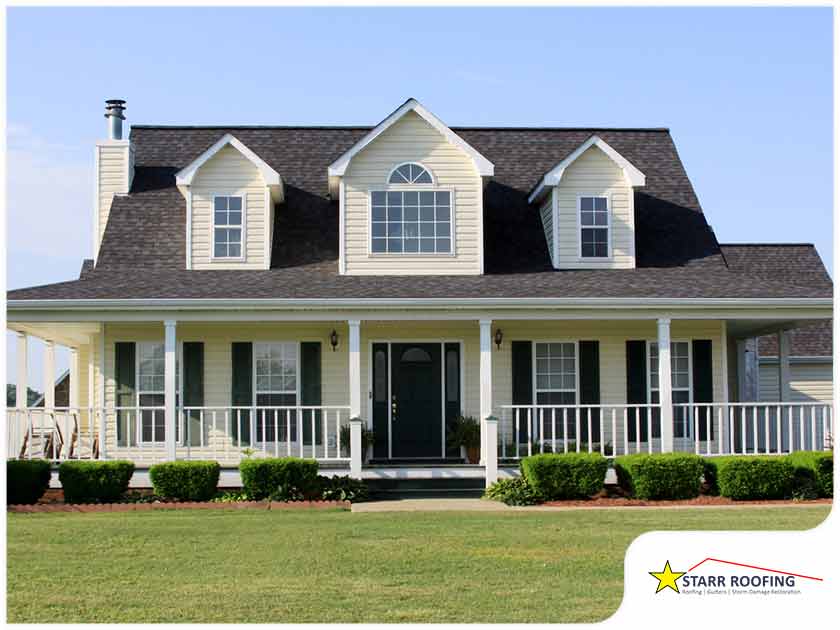There are many variables that factor into planning and choosing a new roof. One of these is the roofing material. A sloped roof is not restricted to any one type of roofing material, which gives you a wide selection of options that will match every requirement your new roof may have. In today’s post, residential roofing contractor STARR Roofing & Gutters shares a quick guide on how to choose the right roofing material for your home.

Roof Pitch
Before we take a look at roofing materials, we need to discuss roof pitch. Roof pitch measures the steepness of a roofing plane. It factors into many aspects of the finished roofing system, from how much rainfall it can handle at any moment, to the material that can be installed on the roof. A typical residential roof has planes with a 9/12 pitch, which means it rises 9 inches for every foot of horizontal run. The higher the rise, the steeper the roof becomes.
When building a new residential roofing system, pitch becomes an important consideration because it can affect the roof installation cost. A steeply-pitched roof has a bigger roof area, which means it will require more materials and more hours of labor. Gutter sizes will also need to match the new roof, because the steeper it is, the faster it will shed rainwater.
Roofing Materials
The following are the types of roofing materials that offered by most roofing companies:
Asphalt Shingles — This is the most common residential roofing system in the country. For most people, it strikes a good balance between upfront cost, expected life span, and performance. It comes in a wide variety of colors and styles, including those that imitate other roofing systems. Asphalt shingles work best on steep roofing slopes.
Metal – Metal roofing is fast becoming one of the most popular roofing systems. It’s lightweight, it’s durable, and has a long expected life span. It also has low thermal mass and works with most types of coatings, both of which help improve a roof’s energy efficiency.
Tile — Tile is one of the oldest roofing systems that are still in use today. It is also one of the most durable, with an expected life span of over 100 years. In addition to traditional clay tiles, concrete tiles are a more affordable option. Tile is much heavier and is more suitable for gently-sloped roofs.
Slate — Slate roofing is made from quarried natural slate. Its natural color varies depending on where the slate is sourced. While dark gray and black are common, you can also find shades of red, green, and blue. Like tile roofing, slate is heavy and has a similar life span. If you’re switching from metal roofing or a similar lightweight roof, your roofing contractor has to make sure the existing structure will be able to support its weight.
Wood — A wood roof can be made from shakes or shingles. It’s not as common as it once was, but it remains a good choice if you need a rustic look, an eco-friendly option, or an authentic look for a historic property.
Factors to Consider When Choosing Roofing Materials
One of the most common mistakes homeowners make is to choose the roof with the lowest upfront cost. Don’t make the same mistake and make sure you consider the following before you make your choice.
Maintenance Requirements — One of the responsibilities of a homeowner is performing regular roof inspections and keeping up with roofing maintenance. Some roofing systems, like wood roofs, require frequent inspections. Others, like metal roofs, have low maintenance requirements.
Service Life — Different roofing materials have different expected life spans. A typical asphalt shingle roof usually lasts 20 to 30 years. As discussed above, metal, slate, and tile roofs last much longer. Roofs with longer service lives tend to have higher upfront costs, but when you factor this along with their maintenance requirements, some of them may actually save you money in the long run.
Energy Efficiency — The right roof can help you save on your indoor cooling costs by reducing the heat that’s absorbed through the roof. A roof with a low thermal mass releases radiant heat faster, which helps reduce the heat that makes it through the roof. Also, consider the roof’s color: light-colored roofs are more reflective, which helps reduce heat absorption during the day.
Other considerations such as home style, color palette, and your local HOA’s rules may also apply, but the factors above should be put first before you make your choice.
STARR Roofing & Gutters is your leading provider of roof inspections, repair, and installation services. Give us a call at (512) 736-6539. You can also fill out our contact form to schedule an appointment.
